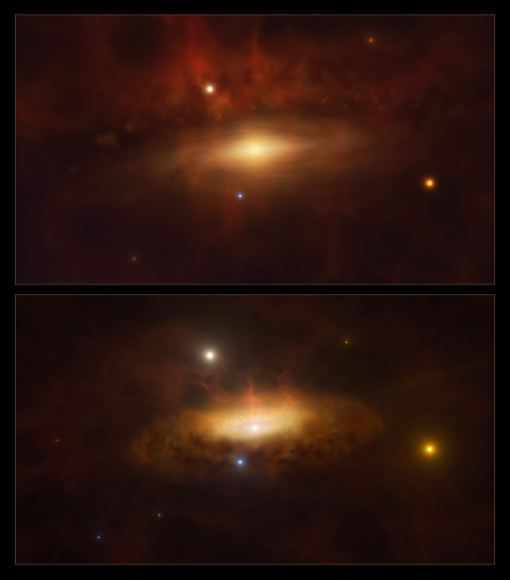Astronomers have witnessed a supermassive black hole awakening in ‘real-time’ for the very first time in history.
In 2009 an enormous black hole at the core of the galaxy SDSS1335+0728 suddenly flared up and emit a flash of energy. This event was the first in which scientists were able to observe the sudden activation of a supermassive black hole in a real-time environment. Paula Sánchez Sáez an astronomer at ESO in Germany and author of the study said that it feels like watching a distant galaxy that was static and uneventful until now.
However, the center of the galaxy started showing fluctuations in brightness, which was not seen earlier to any such levels. Therefore, this nuclear transient has categorized SDSS1335+0728 officially to have an active galactic nucleus (AGN). This suggests that the galaxy has now a very bright and dense region in its center. This light increase has fascinated astronomers because they are interested in the reason behind these celestial bodies ‘awakening’.

Looking for Transients in all the Right Places
In California, the Zwicky Transient Facility identified unexplained changes in brightness. This facility offering constant alert of any spike in brightness in galaxy like SDSS1335+0728 as it has been mentioned. Other observatories also measured these fluctuations, and when more data from the archives was analyzed, variations in the brightness were noted.
These flares could be due to several reasons or activities for instance, stars and gaseous clouds can be consumed when they get too close to supermassive black holes. Surveys and observations are used by astronomers to assess the occurrence of the events and how a quiescent galactic nucleus turns into an active galactic nucleus. Their discoveries include not only galaxies far away but the phenomena associated directly with the supermassive black hole situated in our galaxy.
A Galaxy and Its Supermassive Black Hole
Almost all galaxies contain supermassive black holes in their nuclei. They tend to contain a hundred thousand, or possibly more, times the mass of the Sun. All things are bound by gravity, and nothing, not even light, can break free. “These giant monsters are usually sleeping and not directly visible,” said Claudio Ricci, one of the researchers, from the Diego Portales University, Chile. “In the case of SDSS1335+0728, we were able to watch the awakening of a giant black hole, [which] began to shine brightly after suddenly actively absorbing gas that is present in the space around it. ”A black hole does not even emit light at all. But instead, it absorbs everything, including the light. Nevertheless, the region near the black hole, called the accretion disk, is somewhat more active. It is where matter is captured by the black hole’s immense gravity and spirals around like water going down a drain. Magnetic fields pass through all of that material which is mostly gas and some dust. The substance gets warm because of abrasion occurring between the accretions. And the act of heating emits radiation. We see light being produced if there is sufficient of it. The level of activity is reflected by the x-rays emitted by the intense active regions.
Gravity’s Slice-and-dice Activity
Tidal disruption occurs when a star or a cloud of gas become stuck in the gravitational field. These things take years to occur. When this happens, the black hole’s gravitational force eventually destroys the star or cloud. That also emits radiation. A extremely slow-motion tidal disruption event may be taking place in the center of SDSS1335+0728. If so, it might be one of the longest and darkest ever seen.
Regardless of the cause of the brightening, some of the material will eventually wind up within the black hole. The rest of material becomes superheated in the accretion disk, signaling its fate with enhanced radiation.
Black Hole Growth and a Wake-up Call
Galactic scale black holes appear small and grow larger due to collision. We do not observe development patterns in live form, since all these developments take millions of years for completion. As stated by the merger scenario, as galaxies unite, so do their central black holes if there exist so. Finally, you wind up with these giant creatures. It just remains seated and feeds on fainting gas particles to assemble mass. That is how they build up volume in this way through acquisitions which take place on shorter periods. This is evidently what the one in SDSS1335+0728 is now doing, as revealed by the HST and adaptive optics images of Figure 1.

It is rare for astronomers conducting their observations to see one wake up and start chewing in the same time frame. Hence a number of issues remain concerning this one especially historical aspect of its creation. The problem with mergers is that they often take years to happen, so it is unclear what happened to this one in the past. Should this be a tidal disturbance then, astronomers need to find out how frequently this happens. Regarding outbursts indicating the supermassive black hole awakening, there were no previous ones identified for SDSS1335+0728.

In more details, as Sánchez Sáez said, astronomers have to perform several subsequent observations to understand what is happening there and searching for the signs of additional eruptions and other activities associated with the black hole. “In any case, this galaxy is important for bringing us information about the growth and development of black holes,” she said, noting that improvements in the detectors of ESO’s Very Large Telescope will help astronomers to watch the activity of this black hole. Moreover, following the nuclear brightenings, future time-domain all-sky surveys with the Vera C. Rubin telescope should be capable of this.
Do not forget to share your opinion with us to provide you with the best posts !



0 Comments